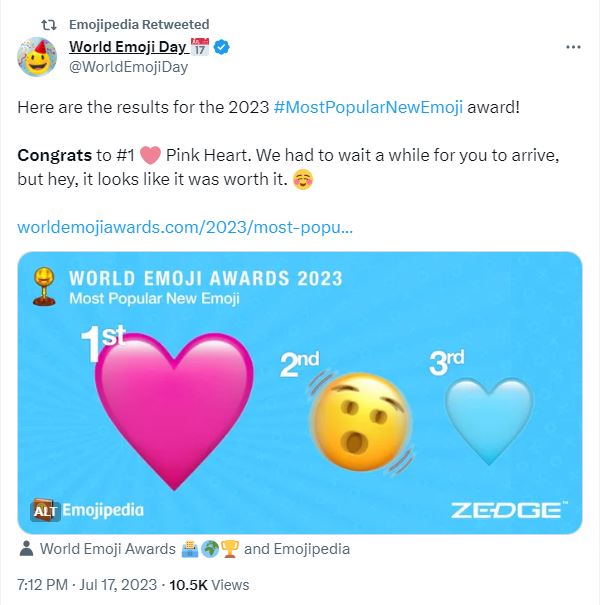
Can employees reply work emails and messages with emojis? (Image – Shutterstock)
Are emojis changing communication methods?
|
Getting your Trinity Audio player ready... |
When it comes to communication methods at work, verbal communication is still the most common, followed by communications over email. As companies continue to expand their business, communication methods have evolved as well.
Communication methods at work can vary depending on a company’s size, industry, culture, and specific communication needs. While most companies rely solely on emails to communicate with their employees, others have evolved to using instant messaging platforms like Slack and Microsoft Teams.
There are also video conferencing communication methods like Zoom, and social media apps like WhatsApp, which some companies prefer to use. Other popular communication methods at work include project management tools like Trello and collaboration tools like Google Docs and Dropbox. Each of these methods has its own unique offerings to meet a company’s communication needs.
When delving deeper into emails, instant messaging, and collaboration tools, employees are reducing the amount of time they spend typing out replies and emails. Instead, there is increased use of emojis to reply to messages at work.
An emoji can be a pictogram, logogram, ideogram, or smiley that is embedded in text and used in electronic messages and web pages. Emojis primarily function as a cue to emotional replies in conversations.
Digital emojis originated on Japanese mobile phones some 25 years ago and became increasingly popular in the 2000s as more mobile phone operating systems and chat platforms included them.

A short history of the emoji. (Image – Statista)
Today, emojis are found in almost every communication tool. Emails, instant messaging platforms, and even video conferencing tools allow users to use emojis to reply to communicate.
According to a 2021 study by Adobe, 55% of global emoji users are more comfortable expressing emotions through emojis instead of phone conversations or facial expressions. Emojis give people the chance to pause and choose an appropriate image to convey how they are feeling and how they hope the other party will feel.

Should employees be allowed to reply work emails with emojis? (Image – Shutterstock)
Interesting facts about emojis
Statistics from Emojipedia show that there are currently 3,664 emojis in the Unicode Standard as of September 2022. This includes sequences for gender or skin tone, flags, and the components that are used to create keycaps, flags, and other sequences. The latest emoji release is Emoji 15.0. The next expected release is Emoji 15.1, currently scheduled for September 2023.
Social media apps have unveiled similar emoji-style icons to boost social engagement as well. For example, the Facebook “Like” icon was soon complemented with other icons for users to show how they felt towards posts. LinkedIn added similar icons for users to react to posts instead of commenting. Zoom has several emojis and icons for users to use during calls, such as “Like”, “Celebrate” and “Raising a hand”.
Today, one in five tweets includes an emoji. There are also five billion emojis sent daily on Facebook Messenger. Half of all comments on Instagram include an emoji, and only 7% of users use the peach emoji to represent a fruit.
During the COVID-19 pandemic, the relative use of positive smiley face emojis was on the decline (down 5.63%). However, there was an increase in the use of the syringe emoji, likely due to the promotion of vaccinations. The tears of joy and loudly crying faces were the most popular emojis in 2022.

A Tweet on the most popular emojis.
Emojis as communication methods
While the premise of emojis being used to express emotions can be accepted for non-work messaging, is it a proper tool for workplace communication? For example, when replying to a supervisor or having business conversations, is a thumbs-up emoji or smiley face emoji sufficient?
In a Forbes report, a study recently published in the journal Social Psychological and Personality Science suggests that including a smiley emoticon or an emoji in a work email may make people think the sender is less competent.
For example, a manager or C-level executive sending an email with a smiley face emoji or even replying to a Teams message with an emoji might be interpreted as not being serious enough in their request. Similarly, an angry emoji used by a leader in a reply could cause undue concern for the recipient.
Interestingly, emoji replies are becoming more accepted in workplaces. A recent report by the BBC noted a judge ruled that a thumbs-up emoji can serve as a digital signature. The case involved a farmer who accidentally replied with a thumbs-up emoji to a contract and disputed it stating that there was no formal agreement. However, in a landmark ruling, the judge stated that the thumbs-up emoji is valid and the farmer would need to meet the requirements of the contract.
A study by Harvard Business Review found that emojis can be an intergenerational and cultural minefield as a communication method. For instance, many Gen Z’s are reportedly offended by their colleagues’ use of the smiley face emoji, which they see as patronizing. The study also emphasized that cultural and geographical nuances can cause misunderstandings; a friendly gesture for one might be offensive to another.
“Offense usually stems from a misinterpretation of a sent emoji or when someone uses an emoji that they think means one thing but really means another. For example, if a manager sends an emoji that features two hands pressed together, does it send a message of gratitude? A request for a favor? Or is it hands clasped in prayer? And is the emoji with the smiling face and two hands signaling a friendly wave “hello” or giving a hug? If you’re not sure, better to avoid using the emoji and to stick with something that is more straightforward and less open to interpretation,” suggested the article.
On the other hand, an Adobe study revealed that 70% of participants believe inclusive emojis can foster positive discussions on significant societal issues. Respondents love using emojis, citing them as aids in overcoming language barriers and fostering connections. Many have initiated meaningful relationships online and made acquaintances with people who speak a different language.
The video below showcases appropriate emojis to enhance workplace communication.
The dark side of emojis
With the rise of emojis in professional communication, cybercriminals may exploit them. Emojis, though seemingly harmless, might be more dangerous than they appear.
According to Satnam Narang, senior staff research engineer at Tenable, in 2022, researchers found a way to deliver exploits to victims through a series of innocent-looking emojis. The researchers found that some software has a hard time processing emojis. This doesn’t mean this software can be hacked with emojis, but it indicates that emojis are novel enough that not all computers and programs support them.
While the circumstances in which this exploit can take place are extremely specific and unlikely to happen in real life, there is no denying that malware could potentially be delivered through innocent-looking emojis.
Another concern highlighted by Narang when it comes to using emojis is how scammers can use them to scam victims. This may not happen a lot at work, but employees communicating with suppliers or those outside their office could easily fall for such scams if they are not careful.
As emojis can be interpreted differently by users, some scammers are using them in romance scams as well as pig butchering scams. Pig butchering scams are a type of fraud in which criminals lure victims into digital relationships to build trust before convincing them to invest in cryptocurrency platforms. However, the fraudsters control the platforms and will eventually take all the money and vanish.
“These conversations utilize familiar emojis, as the language of the modern internet to express feelings of playfulness, love and romance. However, what lies behind those emojis are users that aren’t who they say they are. These scammers have one goal in mind and that is to convince users through the promise of fake investments or pleas for financial assistance in order to steal money from victims. Pig butchering scammers and romance scammers thrive on interaction through social media and dating apps. Users of both types of platforms should be wary of investment offers or requests for financial aid,” mentioned Narang.
He highlighted that emojis imbue the text with emotional richness and foster better expressivity in virtual interactions, be it for work or outside work, and they are not devoid of pitfalls. The most immediate concern is the use of emojis as part of romance scams, which can have the most impact on everyday users online.

Emojis are a part of workplace communication methods. (Image – Shutterstock)
A simpler communication method?
In conclusion, while some may feel it is alright to use emojis for workplace communication, it ultimately comes down to the company culture. There is definitely a generation gap between those that prefer using emojis as replies and those that prefer replying to work emails in full sentences.
However, the reality is, emojis are indeed part of the modern communication method at work. Smiley faces and thumbs up will continue to appear in communication tools and employees will have to be sure they are using emojis properly to avoid any misinterpretation among teams.
At the end of the day, having some imagery in workplace communication could help employees connect with concepts and ideas more deeply compared to words alone.
READ MORE
- Safer Automation: How Sophic and Firmus Succeeded in Malaysia with MDEC’s Support
- Privilege granted, not gained: Intelligent authorization for enhanced infrastructure productivity
- Low-Code produces the Proof-of-Possibilities
- New Wearables Enable Staff to Work Faster and Safer
- Experts weigh in on Oracle’s departure from adland


